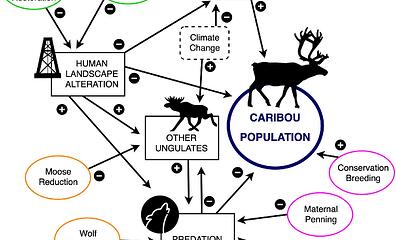WildLift: An open-source tool to guide decisions for wildlife conservation
Authors: Sólymos, P., Nagy-Reis, M., Dickie, M., Gilbert, S., Serrouya, R.
Abstract: WildLift can be used to quantitatively compare the costs and demographic benefits of recovery actions for an iconic threatened species, woodland caribou. While we use caribou as a case study, our approach to developing this management tool is transferable to other threatened taxa.
Full Description: A recurring challenge for resource managers and decision makers is quantifying the trade-offs associated with alternative recovery actions for threatened species. Structured decision-making approaches can help evaluate such complex problems by formalizing objectives and constraints into functions that quantify the benefits and costs associated with each action. Yet, many of the scientific tools necessary to implement structured decision making require extensive literature review and often involve complex algorithms that make them inaccessible to managers.
To address these issues, we integrated available information and developed a decision-support tool that managers can readily use to compare costs and benefits associated with alternative recovery actions for threatened species. Our software can be used to quantitatively estimate and compare the costs and demographic benefits of recovery actions for an iconic threatened species, woodland caribou. While we use caribou as a case study, our approach to developing this management tool is transferable to other threatened taxa.
The tool consists of a generalized matrix population model that is parametrized based on information from the published literature or ongoing experiments. Users can input population parameters (e.g., population size and survival rates) or choose from pre-set caribou subpopulations to estimate changes to populations from implementing recovery actions. The tool estimates the trade-offs associated with seven alternative recovery actions.
Single levers
The tool estimates the trade-offs associated with seven alternative recovery actions:
- Linear Feature Restoration,
- Linear Feature Deactivation,
- Maternal Penning,
- Conservation Breeding,
- Predator Exclosure,
- Wolf Reduction, and
- Moose Reduction.
Multiple levers
Multiple recovery actions are compared allowing users to combine demographic augmentation (maternal penning, predator exclosure, and conservation breeding) with predator and primary prey reductions.
Citation
Nagy-Reis, M., Dickie, M., Sólymos, P., Gilbert, S., DeMars, C., Serrouya, R., and Boutin, S., 2020. WildLift: An open-source tool to guide decisions for wildlife conservation. Frontiers in Ecology and Evolution, 8:564508. DOI 10.3389/fevo.2020.564508
Keywords: ecology, wildlife, decision making, conservation, decision support
Shiny app: https://abbiodiversity.shinyapps.io/WildLift/
Repo: GitHub - ABbiodiversity/WildLift: An Open-source Tool to Guide Decisions for Wildlife Conservation
RStudio Cloud: Posit Cloud
Thumbnail:
Full image:
